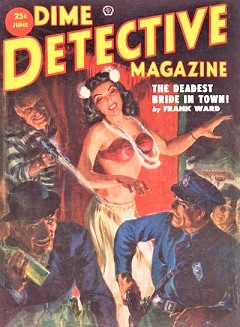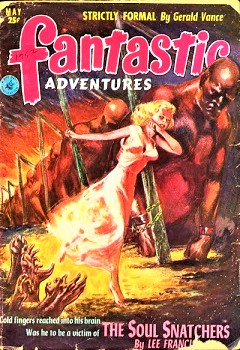
 “The Black Museum. A Repository of Death. Here in the grim stone structure on the Thames which houses Scotland Yard is a warehouse of homicide, where everyday objects . . . all are touched by murder.“
“The Black Museum. A Repository of Death. Here in the grim stone structure on the Thames which houses Scotland Yard is a warehouse of homicide, where everyday objects . . . all are touched by murder.“
The Black Museum (1952) aired (in the United States and as near as historians can reasonably ascertain) “Four Small Bottles” on May 20, 1952. This is only the fourth episode we’ve run of this show (the first three being in January, April, and October of 2018) so a bit of background is in order for newcomers to this sometimes grisly program. First of all, the name the Black Museum was coined in 1877 by a reporter for London’s The Observer newspaper, though the museum had opened in 1875 with the official name of simply the Crime Museum. It is the oldest museum in the world to display only artifacts of crime and is still known today by its official name of the Crime Museum despite the more colorful name given it by The Observer. The museum is not open to the public and is used primarily for instructional purposes for police training, but has had special visitors the likes of Sir Arthur Conan Doyle.
The Black Museum was one of four similar shows produced by Harry Alan Towers (1920-2009) under his Towers of London label in the late 1940s and early 1950s. Towers, a native born Britisher, would also produce popular radio fare like Secrets of Scotland Yard, Fabian of the Yard, and WHItehall 1212. All four shows centered around stories from the files of Scotland Yard, and New Scotland Yard’s famous Crime Museum, which was popularized in crime novels as the Black Museum. While all but Fabian of the Yard are verified as being produced and syndicated in Britain for future syndication, it is interesting to note that, according to the Digital Deli Too website entry, “WHItehall 1212 was a National Broadcasting Corporation production written by Lights Out’s famous scriptwriter Wyllis Cooper….” Three of the four shows, The Black Museum among them, would wrap their stories around an artifact from the museum, recounting in dramatic form the infamous crime associated with said artifact. Secrets of Scotland Yard kept to historical facts quite closely, and while a fascinating listen and quite popular, didn’t have the flair or melodramatic effect the likes of Orson Welles (1915-1985) would bring to The Black Museum as the host and narrator of each of its 52 episodes. And while The Black Museum also kept to the historical record surrounding each case, it would play a little fast and loose with them (or perhaps embellish them is the proper word) for dramatic effect, and it didn’t hurt that the show–unlike the others–drew its material solely from murders, thus guaranteeing the audience a chilling half hour. Overlay the grim stories with the somber, virtually hypnotic tones of Orson Welles and you’ve got a winner.

 Speaking of Orson Welles, one might be given to wonder how he came to write some of, and host and narrate all of the episodes of The Black Museum, which were produced in the UK. It seems that Welles decided to take an extended “vacation” in England due to several professional and personal problems, including some “requests” from the Internal Revenue Service. So the American loss turned into Harry Alan Towers’s gain (Towers’s photo at left 1948, at right circa 1984), and he set Welles to work, a profitable solution for both parties. Welles would also work on two other Towers productions, perhaps the most well known to the American radio audience being The Lives of Harry Lime (or The Third Man.) The Third Man was a 1949 film noir British production set in post-World War II Vienna, with Welles playing the Lime character. Written by Graham Greene, it has attained classic status for its stylish portrayal of a decaying and corrupt Vienna, so Towers was striking while the iron was hot and rode the coattails of the film with Welles starring in the radio adaptation.
Speaking of Orson Welles, one might be given to wonder how he came to write some of, and host and narrate all of the episodes of The Black Museum, which were produced in the UK. It seems that Welles decided to take an extended “vacation” in England due to several professional and personal problems, including some “requests” from the Internal Revenue Service. So the American loss turned into Harry Alan Towers’s gain (Towers’s photo at left 1948, at right circa 1984), and he set Welles to work, a profitable solution for both parties. Welles would also work on two other Towers productions, perhaps the most well known to the American radio audience being The Lives of Harry Lime (or The Third Man.) The Third Man was a 1949 film noir British production set in post-World War II Vienna, with Welles playing the Lime character. Written by Graham Greene, it has attained classic status for its stylish portrayal of a decaying and corrupt Vienna, so Towers was striking while the iron was hot and rode the coattails of the film with Welles starring in the radio adaptation.
The airing of The Black Museum episodes presents problems for historians. Produced in 1950, it was first aired as a “pirate broadcast” by Radio Luxembourg, and then throughout Europe. It was eventually licensed by MGM Radio Attractions and ran in the United States under the Mutual Broadcasting System (MBS). MGM hand-picked what it considered to be the best 39 of the original 52 episodes and ran them from January 1, 1952 through December 30, 1952 (with a three month hiatus while a summer replacement filled the gap). This is the run from which we have taken “Four Small Bottles.” There’s more to the odd packaging and eventual airing of select episodes of The Black Museum (Canada’s CBC radio would also purchase some 38-39 episodes and air them at different times than the American run, for but one example), but all of that is neither here nor there for our current purposes.
“Four Small Bottles” tells of murder by a nearly medically impossible method, and how discovering the murderer turns out to be the real puzzler. For this is the strange but true tale of an older man during the Edwardian era who felt that there were two kinds of women–one meant to cook and clean, and the other to be educated as an intellectual companion to the husband–and how this older man opted for the latter and what befell him as the result of “Four Small Bottles.” See if you agree with the jury in this odd case and why the title glassware ended up as an exhibit in the Black Museum.
Play Time: 26:08
{After listening to this tale of murder, at least one member of the neighborhood gang was influenced to find more stories of a darker nature, and the corner newsstand was just the place to find them. Dime Detective (1931-53) was chock full of nefarious deeds and deadly schemes and was a bi-monthly in 1952. fantastic Adventures (1939-53) also offered tales of nefarious deeds and mortal danger, but took place on faraway worlds and in times that never were. It was a monthly in 1952. Newcomer Galaxy SF (1950-80), while accepting stories of a more traditional nature as shown on the cover below, also presented stories where the danger and drama was of a more hidden or subtle nature (the perceived evils of advertising or technology, for instance). It, too, was a monthly in 1952.}
[Left: Dime Detective, June 1952 – Center: fantastic Adventures, May 1952 – Right: Galaxy, May 1952]



To view the entire list of weekly Old Time Radio episodes at Tangent Online, click here.